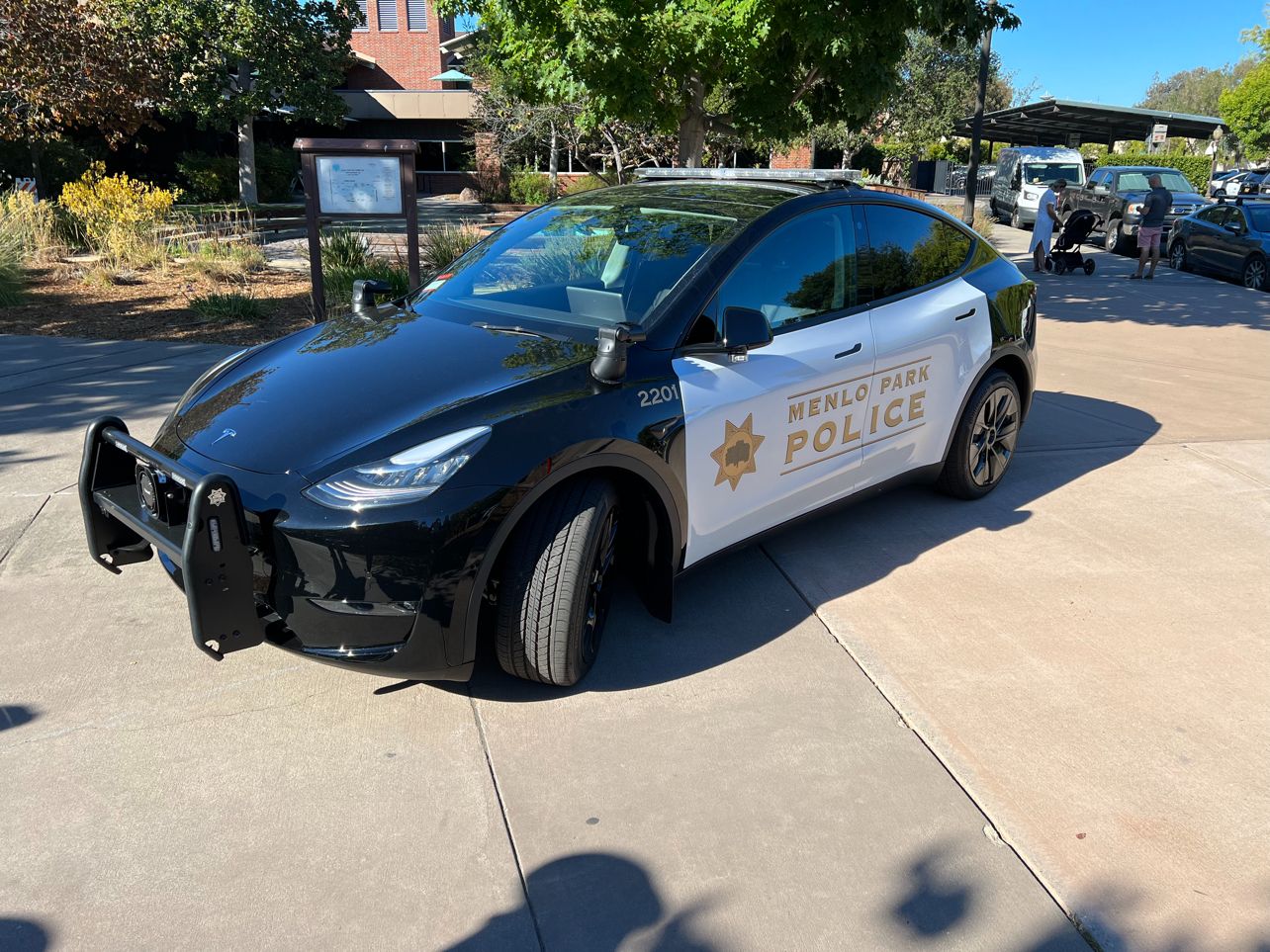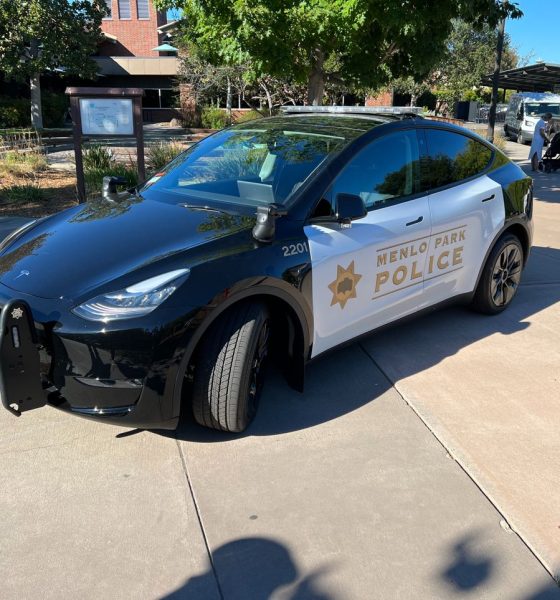

News
Tesla gets its first negative review from a police force standpoint
Tesla vehicles have been adopted by several police forces across the United States, and they have widely been met with positive reviews, mainly driven by cost savings and performance advantages.
However, one department has found the Tesla fleet to be less than ideal, even going as far as saying “(they) do not appear to the be the ‘patrol cars of the future.’”
In 2019, the Menlo Park, California City Council voted 3-2 to adopt a Sustainable Fleet Policy in 2020. The Model Y Long Range was chosen as the vehicle for the Menlo Park Police Department, beating out the Ford Mustang Mach-E and some other EVs.
Three units make up the EV portion of the Menlo Park Police Fleet.
Teslas need to be outfitted and modified for police use. Lights, sirens, seats, specialized seatbelts, communications equipment, a gun rack, window guards, and ballistic door panels are all equipped to make it a full-fledged law enforcement vehicle.
Tesla Model Y showcased at Menlo Park Police employee appreciation event
Outfitting a Tesla Model Y was roughly $12,700 more expensive than a Ford Explorer Hybrid, and the difference when also factoring in the initial cost of the vehicle came to $25,355, a 33 percent increase for the Tesla compared to the Ford.

Other police departments have canceled out the difference in initial cost after just a year of operation.
Officers also said the “small interior space” and “smart car” features, along with the low vehicle profile all made things more difficult.
Space Constraints
In terms of space constraints, after the vehicle is outfitted for patrol use, there is a “reduce amount of space for an officer in full patrol gear.” The report, released by the Menlo Park City Council, said:
“The width of duty belts and bulletproof vests do not fit well in the bucket seat and the height of the center console required larger officers to sit at an angle or with their sidearm pinned and inaccessible while in the vehicle. The equipment overhangs the passenger seat making it nearly unusable. This is not an immediate issue, as the current patrol operations do not deploy two officers in every vehicle, but would limit the ability to transport personnel or change operations in the future. In particular, the passenger seat space would not allow training officers to comfortably sit next to a trainee for a 12-hour shift, preventing field training for new officers. The rear seats provide very little room for anyone detained or transported in the back of the car.”
“Smart Car” Challenges
The Menlo Park PD listed Autopilot interference, lighting controls, and proximity locking, sleep mode, and self-closing doors as disadvantages:
“The following “smart” features of the Teslas created challenges for patrol operations:
-
- Autopilot interference: There is a delay when officers shift into drive; and on occasion the Teslas automatically stop when an officer attempts to pull off to the side of the road to approach vehicles or people.
- Lighting controls (tablet): Tesla does not allow direct access to the system; officers need to use a multistep touch screen process to follow standard practice to dim their lights upon approach at night.
- Proximity locking, sleep mode and self-closing doors: The car knows when the key is, or is not, present within an effective range. The cars will not lock if the key, or enabled smartphone, are near the vehicles and will conversely lock if the key or smartphone is away from the vehicle.”
According to Almanac News, Menlo Park’s local news, the City Council approved the purchase of a Chevrolet Blazer for a future Police vehicle. It appears the Department is just not set on the Tesla for police use.
“I am very proud that we tried the Teslas, and not everything works,” Betty Nash, a Council member, said. “I appreciate all the work that the police department did with working through all the bumps.”
I’d love to hear from you! If you have any comments, concerns, or questions, please email me at joey@teslarati.com. You can also reach me on Twitter @KlenderJoey, or if you have news tips, you can email us at tips@teslarati.com.

News
Tesla FSD fleet is nearing 7 billion total miles, including 2.5 billion city miles
As can be seen on Tesla’s official FSD webpage, vehicles equipped with the system have now navigated over 6.99 billion miles.

Tesla’s Full Self-Driving (Supervised) fleet is closing in on almost 7 billion total miles driven, as per data posted by the company on its official FSD webpage.
These figures hint at the massive scale of data fueling Tesla’s rapid FSD improvements, which have been quite notable as of late.
FSD mileage milestones
As can be seen on Tesla’s official FSD webpage, vehicles equipped with the system have now navigated over 6.99 billion miles. Tesla owner and avid FSD tester Whole Mars Catalog also shared a screenshot indicating that from the nearly 7 billion miles traveled by the FSD fleet, more than 2.5 billion miles were driven inside cities.
City miles are particularly valuable for complex urban scenarios like unprotected turns, pedestrian interactions, and traffic lights. This is also the difference-maker for FSD, as only complex solutions, such as Waymo’s self-driving taxis, operate similarly on inner-city streets. And even then, incidents such as the San Francisco blackouts have proven challenging for sensor-rich vehicles like Waymos.
Tesla’s data edge
Tesla has a number of advantages in the autonomous vehicle sector, one of which is the size of its fleet and the number of vehicles training FSD on real-world roads. Tesla’s nearly 7 billion FSD miles then allow the company to roll out updates that make its vehicles behave like they are being driven by experienced drivers, even if they are operating on their own.
So notable are Tesla’s improvements to FSD that NVIDIA Director of Robotics Jim Fan, after experiencing FSD v14, noted that the system is the first AI that passes what he described as a “Physical Turing Test.”
“Despite knowing exactly how robot learning works, I still find it magical watching the steering wheel turn by itself. First it feels surreal, next it becomes routine. Then, like the smartphone, taking it away actively hurts. This is how humanity gets rewired and glued to god-like technologies,” Fan wrote in a post on X.
News
Tesla starts showing how FSD will change lives in Europe
Local officials tested the system on narrow country roads and were impressed by FSD’s smooth, human-like driving, with some calling the service a game-changer for everyday life in areas that are far from urban centers.

Tesla has launched Europe’s first public shuttle service using Full Self-Driving (Supervised) in the rural Eifelkreis Bitburg-Prüm region of Germany, demonstrating how the technology can restore independence and mobility for people who struggle with limited transport options.
Local officials tested the system on narrow country roads and were impressed by FSD’s smooth, human-like driving, with some calling the service a game-changer for everyday life in areas that are far from urban centers.
Officials see real impact on rural residents
Arzfeld Mayor Johannes Kuhl and District Administrator Andreas Kruppert personally tested the Tesla shuttle service. This allowed them to see just how well FSD navigated winding lanes and rural roads confidently. Kruppert said, “Autonomous driving sounds like science fiction to many, but we simply see here that it works totally well in rural regions too.” Kuhl, for his part, also noted that FSD “feels like a very experienced driver.”
The pilot complements the area’s “Citizen Bus” program, which provides on-demand rides for elderly residents who can no longer drive themselves. Tesla Europe shared a video of a demonstration of the service, highlighting how FSD gives people their freedom back, even in places where public transport is not as prevalent.
What the Ministry for Economic Affairs and Transport says
Rhineland-Palatinate’s Minister Daniela Schmitt supported the project, praising the collaboration that made this “first of its kind in Europe” possible. As per the ministry, the rural rollout for the service shows FSD’s potential beyond major cities, and it delivers tangible benefits like grocery runs, doctor visits, and social connections for isolated residents.
“Reliable and flexible mobility is especially vital in rural areas. With the launch of a shuttle service using self-driving vehicles (FSD supervised) by Tesla in the Eifelkreis Bitburg-Prüm, an innovative pilot project is now getting underway that complements local community bus services. It is the first project of its kind in Europe.
“The result is a real gain for rural mobility: greater accessibility, more flexibility and tangible benefits for everyday life. A strong signal for innovation, cooperation and future-oriented mobility beyond urban centers,” the ministry wrote in a LinkedIn post.
News
Tesla China quietly posts Robotaxi-related job listing
Tesla China is currently seeking a Low Voltage Electrical Engineer to work on circuit board design for the company’s autonomous vehicles.

Tesla has posted a new job listing in Shanghai explicitly tied to its Robotaxi program, fueling speculation that the company is preparing to launch its dedicated autonomous ride-hailing service in China.
As noted in the listing, Tesla China is currently seeking a Low Voltage Electrical Engineer to work on circuit board design for the company’s autonomous vehicles.
Robotaxi-specific role
The listing, which was shared on social media platform X by industry watcher @tslaming, suggested that Tesla China is looking to fill the role urgently. The job listing itself specifically mentions that the person hired for the role will be working on the Low Voltage Hardware team, which would design the circuit boards that would serve as the nervous system of the Robotaxi.
Key tasks for the role, as indicated in the job listing, include collaboration with PCB layout, firmware, mechanical, program management, and validation teams, among other responsibilities. The role is based in Shanghai.
China Robotaxi launch
China represents a massive potential market for robotaxis, with its dense urban centers and supportive policies in select cities. Tesla has limited permission to roll out FSD in the country, though despite this, its vehicles have been hailed as among the best in the market when it comes to autonomous features. So far, at least, it appears that China supports Tesla’s FSD and Robotaxi rollout.
This was hinted at in November, when Tesla brought the Cybercab to the 8th China International Import Expo (CIIE) in Shanghai, marking the first time that the autonomous two-seater was brought to the Asia-Pacific region. The vehicle, despite not having a release date in China, received a significant amount of interest among the event’s attendees.








